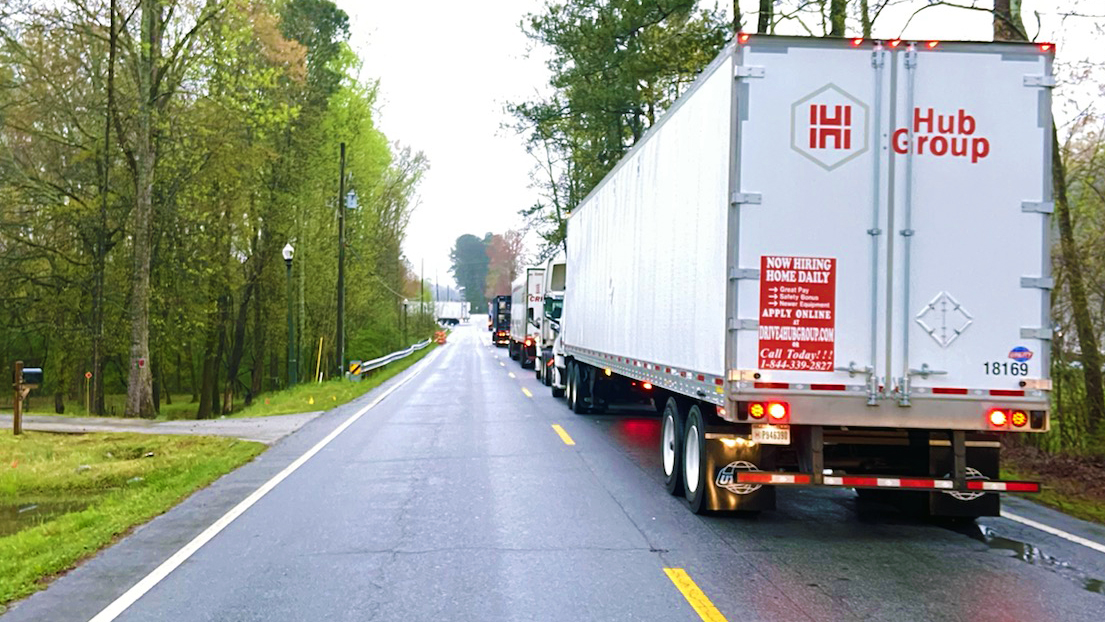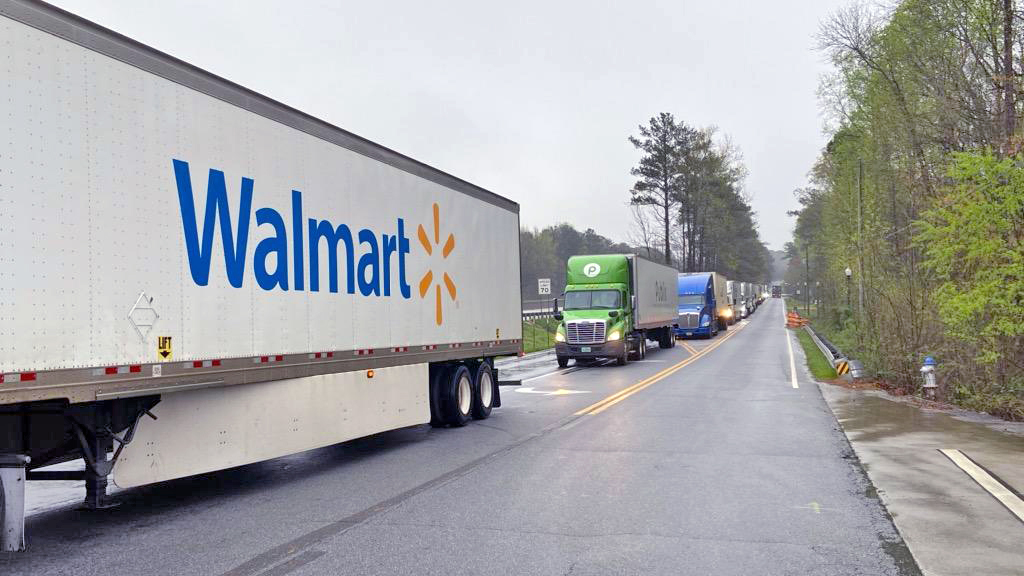

A line of trucks seen last week outside a Clorox manufacturing plant in Fairborne, GA
Last week, President Trump signed into law the biggest economic recovery package in American history, marking the third phase of emergency relief legislation Congress has passed in response to the COVID-19 crisis.
The Coronavirus Aid, Relief, and Economic Security (CARES) Act provides financial assistance to employers and independent contractors through lending programs backed by the Small Business Administration, U.S. Treasury Department and Federal Reserve. The new law totals 880 pages, authorizing more than $2 trillion in new federal spending to stabilize and stimulate the economy.
Here are key provisions for motor carriers:
Small Business Loans
For independent contractors, small- and mid-size carriers, the CARES Act creates new SBA lending programs, and expands upon existing ones, to help maintain payrolls and other business expenses.
Paycheck Protection Program
For ICs and businesses with 500 or fewer employees, or who otherwise meet SBA size standards, the newly created Paycheck Protection Program provides eight weeks of cash-flow assistance through 100% federally guaranteed loans to maintain payroll during this emergency. The loan size would equal 250% of an employer’s average monthly payroll, with a maximum loan amount of $10 million and a maximum interest rate of 4%. Loan payments will be deferred six months, and the program will be available retroactively from February 15, 2020—enabling employers to rehire any recently laid-off employees through June 30, 2020.
PPP loans can be used to cover costs of:
- Employee salaries and commissions;
- Insurance premiums and other group healthcare benefits during periods of paid sick, medical, or family leave;
- Mortgage interest payments;
- Rent and utilities; and
- Interest on debt obligations that were incurred before the covered period.
These small business borrowers are eligible for partial loan forgiveness subject to certain conditions.
Frequently asked questions:
How can I capitalize on the Paycheck Protection Program to receive eight weeks of payroll cash-flow assistance?
Carriers interested in the Paycheck Protection Program can contact their financial institution and ask if they are a SBA 7(a) approved lender or if they intend to participate in the PPP loan program.The application can be found here. Information on finding an approved SBA lender can be found here.
How soon can I apply for PPP loans?
Starting April 3, 2020, small businesses and sole proprietorships can apply. For ICs and self-employed individuals, the application window opens April 10, 2020.
Is there a deadline to apply?
Applicants are eligible to apply for the loan until June 30, 2020.
Is any documentation required?
Documentation verifying the business was operational after February 15, 2020, and had employees for whom they paid salaries and payroll taxes (or a paid independent contractor), is required. More information on the application is available here from the Treasury Department.
Debt Relief
The CARES Act requires SBA to pay all principal, interest and fees on existing SBA loan products (outside of PPP loans) including 7(a), Community Advantage, 504 and Microloan programs—for a period up to six months.
Express Loans
The Cares Act increases the maximum amount of SBA express loans, which can be obtained in a streamlined process for a variety of business needs, from $350,000 to $1 million.
Disaster Loans
The new law also expands eligibility for entities suffering economic harm from COVID-19 to access SBA’s Economic Injury Disaster Loans, while also giving SBA more flexibility to process and disperse small dollar loans. In addition, businesses that apply for an EIDL expedited access to capital through an Emergency Grant—an advance of $10,000 within three days to maintain payroll, provide paid sick leave and to service other debt obligations.
How can I apply for an EIDL loan?
Click here. The SBA District Offices are another good resource when applying for SBA assistance.
Large Employer and Industry Support
Larger businesses will be eligible for assistance in the form of loans, loan guarantees and investments through Federal Reserve lending programs. The CARES Act allocates $454 billion to the U.S. Treasury’s Exchange Stabilization fund for this purpose.
Among other requirements, firms receiving loans will be prohibited from engaging in stock buybacks for the duration of the loan plus one year. Borrowers must, until September 30, 2020, maintain their employment levels as of March 24, 2020, to the extent practicable, and retain no less than 90% of their employees as of that date.
The law requires the Treasury Secretary to publish application procedures and minimum requirements by April 6, 2020. More information will be published at treasurgy.gov/cares.
Employee Retention Tax Credits
The CARES Act created a program called the Employee Retention Credit to provide a refundable payroll tax credit of 50% of wages paid by employers to employees during the COVID-19 timeframe. To qualify, a business must either have operations fully or partially suspended due to a COVID-19 shut down order OR have gross receipts decline by more than 50% when compared to the same quarter in the prior year.
Eligible businesses can get a refundable 50% tax credit on wages up to $10,000 per employee. The credit can be obtained on wages paid or incurred from March 13, 2020 through December 31, 2020. If an employer has more than 100 full-time employees, qualified wages for the credit are wages paid to employees when they are not providing services due to the COVID-19 virus. If an employer has less than 100 full-time employees, all employee wages qualify for the credit whether the employer has suspended business or is open and operating. Processes for receiving the credit are being formulated by the Treasury Department. Additional information is available here.
Important note: If an employer receives a Paycheck Protection Program loan, it not eligible for a tax credit.
Direct Assistance to Individuals and Families
The CARES Act also provides direct financial assistance to most American citizens, depending on income level. U.S. residents or citizens with adjusted gross income under $75,000 ($112,500 for head of household / $150,000, married), who are not the dependent of another taxpayer and have a work-eligible Social Security Number, are eligible for the full $1,200 ($2,400 married) rebate. They are also eligible for an additional $500 per child. A typical family of four is eligible for a $3,400 recovery rebate. More information is available here from Senate Finance Committee here.